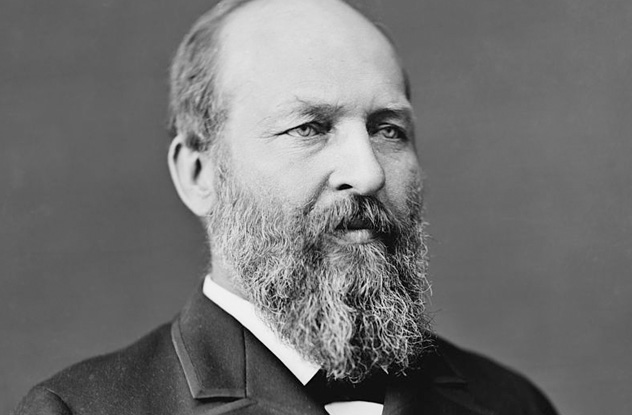 Our World
Our World  Our World
Our World  Weird Stuff
Weird Stuff 10 Fascinating Facts You Might Not Know About Snow
 Miscellaneous
Miscellaneous Top 10 Things Crypto Was Supposed to Change & What Actually Did
 History
History 10 Huge Historical Events That Happened on Christmas Eve
 Music
Music 10 Surprising Origin Stories of Your Favorite Holiday Songs
 History
History 10 Less Than Jolly Events That Occurred on December 25
 Weird Stuff
Weird Stuff 10 Funny Ways That Researchers Overthink Christmas
 Politics
Politics 10 Political Scandals That Sent Crowds Into the Streets
 Weird Stuff
Weird Stuff Ten Bizarre Facts About The Doge Meme
 Our World
Our World 10 Ways Your Christmas Tree Is More Lit Than You Think
 Our World
Our World 10 Archaeological Discoveries of 2025 That Refined History
 Weird Stuff
Weird Stuff 10 Fascinating Facts You Might Not Know About Snow
 Miscellaneous
Miscellaneous Top 10 Things Crypto Was Supposed to Change & What Actually Did
Who's Behind Listverse?

Jamie Frater
Head Editor
Jamie founded Listverse due to an insatiable desire to share fascinating, obscure, and bizarre facts. He has been a guest speaker on numerous national radio and television stations and is a five time published author.
More About Us History
History 10 Huge Historical Events That Happened on Christmas Eve
 Music
Music 10 Surprising Origin Stories of Your Favorite Holiday Songs
 History
History 10 Less Than Jolly Events That Occurred on December 25
 Weird Stuff
Weird Stuff 10 Funny Ways That Researchers Overthink Christmas
 Politics
Politics 10 Political Scandals That Sent Crowds Into the Streets
 Weird Stuff
Weird Stuff Ten Bizarre Facts About The Doge Meme
 Our World
Our World 10 Ways Your Christmas Tree Is More Lit Than You Think
10 Famous People Killed By Their Doctors
Doctors heal us and, if they are not sociopaths, do their best not to hurt us. But doctors work with us when our bodies are weakest. It is inevitable that, sometimes, a doctor’s intervention will kill rather than cure.
10King George V

Kings can usually count on the best of everything. The best food, the best castles, and the best medical treatment. That is why kings generally live longer lives than the peasants they rule over.
King George V of the United Kingdom was actually killed by his status. The king was already dying but not nearly swiftly enough to be convenient. Once he fell into a coma, it seemed that the monarch’s last breath would happen too late for the deadlines of the morning papers. This would result in the king’s passing being reported in the evening papers. To make sure the prestigious morning papers got the story instead, the king’s doctor, Lord Dawson, injected him with cocaine and morphine to speed up his death.
9President Garfield

Being President of the United States definitely takes its toll on health—the before and after photos of presidents show how it ages them. Even worse is the risk of assassination.
President Garfield was shot in 1881 by Charles Guiteau. The assassin’s bullet lodged behind the president’s pancreas but almost certainly was not fatal by itself. What seems to have killed the president was infection caused by his doctors.
Immediately after the shooting, they probed the wound to find the bullet with their fingers. Their unsterilized digits introduced germs that brought on a fever. They tried again and again to find the bullet, each time without sterilizing hands or tools, one doctor even puncturing the president’s liver with his finger. Eighty days after the shooting, the president succumbed to infection.
8Sigmund Freud

Not all famous people who die at the hands of their doctors are the victims of misconduct, ignorance, or malice. Sigmund Freud is often quoted as saying, “Sometimes a cigar is just a cigar,” but other times, a cigar is cause of oral cancer The psychiatrist was fond of his phallic nicotine delivery systems, smoking up to 20 a day.
For the last decades of his life Freud suffered from painful cancers of the mouth. When he came to the end of his life, Freud told his doctor how he wanted to exit the world—painlessly. At Freud’s request, his doctor eased his passing with injections of morphine.
7President Washington

Of all the medical terrors that may face us, a sore throat is probably not the first that comes to mind.
George Washington went out riding one day in the snow, dined without changing from his wet clothes, and the next day reported a sore throat. When an infection in the president’s throat swelled it uncomfortably, his doctor gave the preferred treatment of the times—he bled him. When this failed, a second doctor raised a blister on his throat to draw out liquids. Then he was bled again. Then an enema was given. Then he was forced to vomit. All these interventions weakened the president, allowing the infection to worsen.
Thanks to the tender ministrations of his doctors, Washington’s last words included: “Doctor, I die hard.”
6Michael Jackson

Michael Jackson was preparing for a new world tour when he suddenly died in 2009. The cause of his death was a powerful anesthetic, propofol.
You may have encountered propofol if you have had a general anesthetic. Jackson’s doctor was using it to treat the singer’s insomnia caused by the stress from the upcoming tour. Using propofol to get a night of sleep is like using an atom bomb to dig a vegetable patch. Sure, you will get the job done, but your cabbages will glow in the dark.
The doctor was sentenced to four years in prison for involuntary manslaughter and was released after two.
5Joan Rivers

The comedienne Joan Rivers was never shy about talking about her cosmetic surgery. She played on it in her routines, joking that “I wish I had a twin, so I could know what I’d look like without plastic surgery.” In 2014, she went into hospital for a routine operation. Complications arose, and she died. Many assumed that this was a case of those who live by the scalpel dying by the scalpel.
In fact, Rivers died after a botched examination of her throat, nothing to do with her devotion to plastic surgery. In 2016, Rivers’s doctors settled a malpractice suit and accepted responsibility for her death.
4Abraham Lincoln

Everyone knows what killed President Lincoln. While he was enjoying a trip to the theater, John Wilkes Booth shot him at point-blank range in the head. Even today, such a wound is likely to be deadly. Case closed?
Not quite. In the Civil War, many people had taken bullets to the brain and lived, so just because it was a dreadful wound does not mean it was a fatal one. It is possible that medical treatment rather than the gun finished off the president.
Doctor Charles Leale was in the theater at the time of the shooting and was the first to reach the president. He reported, “The coagula I easily removed and passed the little finger of my left hand through the perfectly smooth opening made by the ball.” Massive damage was done by the bullet but the probing of the wound, repeated later by other doctors, may have caused deadly blood loss.
3King Charles II

We have seen that position and power is no guarantee of flawless medical care. King Charles II of England suffered from an overabundance of doctors. Fourteen medics cared for him in his final days, and all wished to try their treatment on the king when the king suffered some sort of fit while shaving. The fit was only the beginning of his ordeal.
He was bled, blistered, bled again, given an emetic, had his head shaved and blistered, given an enema, and dressed with plasters made of pigeon droppings. That was only the first day of his treatment. Over the next few days, ever more blood was taken, and stranger remedies were tried.
The Merry Monarch died in pain but still found time for courtesy. When visitors were allowed to see him, he apologized: “You must pardon me, gentlemen, for being a most unconscionable time a-dying.”
2Edward Gibbon

Edward Gibbon’s Decline and Fall of the Roman Empire is one of the masterpieces of historical writing. There is, however, a fact about the historian that is often left out of the history books. Gibbon suffered from a swelling of the testicles.
People today may laugh over the absurd tightness of skinny jeans, but they have nothing on the tightness of breaches in the 18th century. There was no disguising the ailment. Gibbon decided to have the illness dealt with. “If the business goes off smoothly, I shall be delivered of a small burden (it is almost as big as a small child).”
Four quarts of watery fluid were drained off in the first operation, which was repeated several times, each drawing out similar amounts. While these treatments relieved the painful and embarrassing condition, they also caused an infection that killed the man.
1Charles II Of Navarre

The second Charles II on this list suffered a bad death, even by the standards of a man known as Charles the Bad (a sobriquet he earned by playing the English and French against each other during the Hundred Years War and switching sides whenever it seemed advantageous).
When Charles fell ill, unable to use his arms and legs, his doctors took an unorthodox approach to curing him. They prescribed wrapping the monarch in brandy-soaked cloth. To give him the maximum exposure, the king was sewn into the cloths at night.
One night, the lady sewing him in had a length of thread left. Instead of cutting off the excess, she decided to burn it off with a candle. As anyone but the lady might have expected, the candle set the alcohol-impregnated bed aflame, killing the king. According to the chronicler Jean Froissart, the king lingered in agony for two weeks before dying, giving moralists a fitting end to the story of Charles the Bad.








